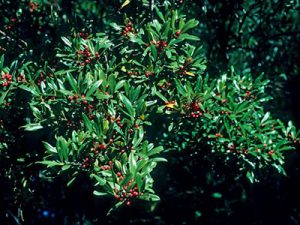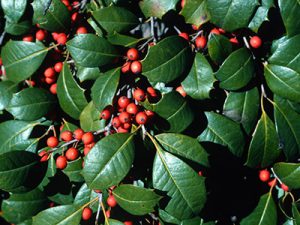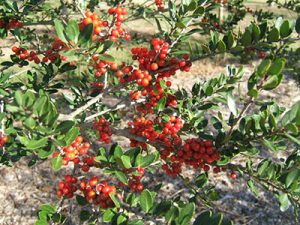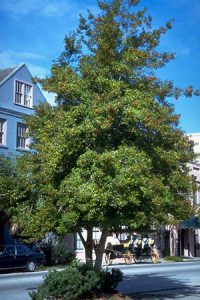Foraging from our native Florida landscape can be a fun and creative way to create unique holiday decorations and gifts. Holly berries make colorful additions to winter wreaths, garland, centerpieces and swags. When gathering, look for various shades and textures of foliage. Gather showy, evergreen foliage, berries and cones from native plants such as Eastern Red Cedar limbs and their bluish berries; palm fronds; fresh pine branches and pine cones; magnolia leaves and seeds; beautyberries; grass seed heads and more to use in your creation. Add a bow or ornament and you’re on your way to creating a one-of-a-kind holiday decoration. This activity can be done with the kids or other family members to create special memories of your holidays, or to give as gifts (without having to mingle with the holiday shopping crowds!).
I’d be remiss without adding an element of plant identification to your holiday crafting, so let’s explore some basic characteristics and differences among Florida’s native hollies—which have gorgeous berries and foliage to add to your creations. Florida is home to several native hollies, notably the Dahoon, American, Yaupon, and a hybrid of American and Dahoon known as ‘East Palatka’. Hollies offer different forms, sizes and functions in the landscape, although one thing they all have in common is they are dioecious (meaning they have separate male and female plants; only the female plants produce berries), evergreen, and alternately arranged along the stem.
The Dahoon Holly, Ilex cassine, has a narrow form at 20’ – 30’ tall by 8’-12’ wide, and leaves that are 2”- 4” long with a few sharp leaves along the upper half. The leaves are thick and stiff, dark green shiny on top, and paler green underneath. It’s evergreen leaves and color resemble the American Holly (Ilex opaca), except the American Holly is stiffer and usually has sharp, spine-toothed margins; and is taller at 30’-50’ by 15’-25’ wide. Also, American holly wouldn’t be found in the poorly drained habitat of the Dahoon. Both have red berries of approximately ¼”.


The Yaupon Holly, Ilex vomitoria, has a rounder shape and modest size of 15’ to 25’ tall by 15’ to 25’ wide. The leaves are small at ½” to 1 ½ “ long with crenate margins, which sets it apart from other native hollies. Female flowers produce abundant nectar while males are rich with pollen, making this an especially attractive tree to bees and beekeepers alike. The 1/4 inch fruits, which can be red, orange or yellow, are a primary food source for many birds throughout the winter. Ilex vomitoria ‘Shillings’ is a popular dwarf shrub in home landscapes and Ilex vomitoria ‘Pendula’ is a classic weeping form. Yaupon Holly is also ecoming popular as an alternative crop grown for tea. Wild yaupons are protected by Florida statute.East Palatka holly.


 0
0
